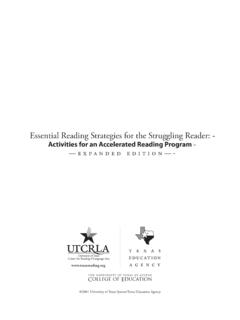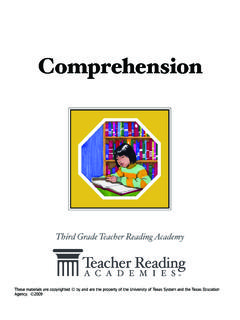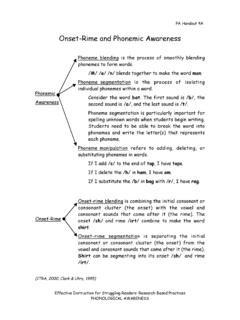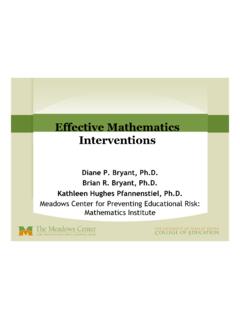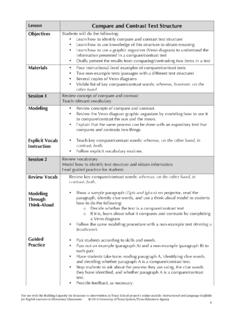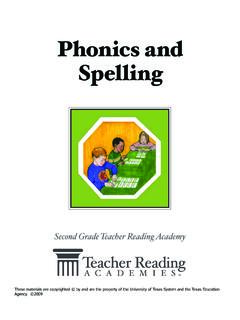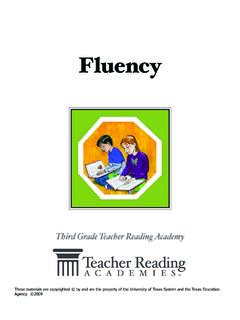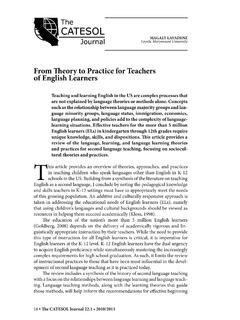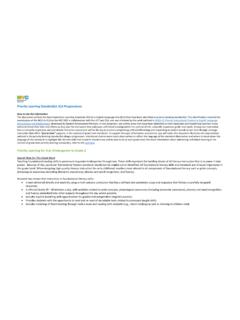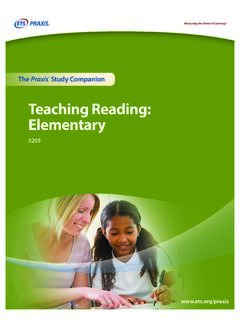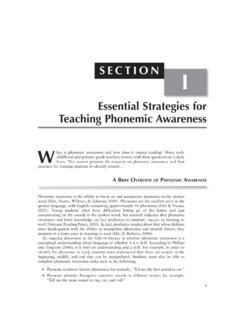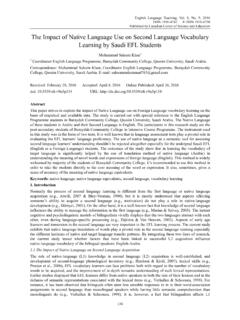Transcription of Reading Strategies & Activities Resource Book
1 Reading Strategies & Activities Resource BookFor Students at Risk for Reading Difficulties, Including Dyslexia 2002 University of Texas System/Texas Education 2004, 2002 The University of Texas System/Texas Education Agency CC-BY-ND-NC InternationalThese materials are copyrighted by and are the property of The University of Texas System and the Texas Education Agency. They may be reproduced under a Creative Commons Attribution-NonCommercial-NoDerivative ( ) Interna-tional License. To view a copy of this license, visit obtain a license to use the materials in a manner not specified above, contact CitationUniversity of Texas Center for Reading and Language Arts. (2004). Reading Strategies and Activities Resource book for students at risk for Reading difficulties, including dyslexia. Austin, TX: AwarenessPhonemic Awareness trategy Set Outline I.) First Sound Lesson 1: Initial Instructional Strategy Isolating First Sounds in WordsLesson 2: Review Strategy Discriminating First SoundsLesson 3: Expansion Strategy Matching First Sounds and Letters in WordsII.
2 Blending Onset-RimeLesson 1: Initial Instructional Strategy Blending Onset-RimesLesson 2: Review Strategy Segmenting and Blending Onsets and RimesLesson 3: Expansion Strategy Integrating Onset-Rime and First Letter IdentificationIII.) Blending Phoneme by PhonemeLesson 1: Initial Instructional Strategy Blending Phonemes in WordsLesson 2: Review Strategy Blending Phonemes Using ManipulativesLesson 3: Expansion Strategy Integrating Letter-Sound Correspondence and Blending IV.) Segmenting Sound by SoundLesson 1: Initial Instructional Strategy Segmenting Sound by Sound: Elkonin BoxesLesson 2: Review Strategy Segmenting Sound by Sound Using FingersLesson 3: Expansion Strategy Segmenting Sound by SoundV.) Deletion and SubstitutionLesson 1: Initial Instructional Strategy Deletion and Substitution of Initial SoundsLesson 2: Review Strategy Deletion and Substitution of Final SoundsLesson 3: Expansion Strategy Deletion and Substitution of Medial Sounds78-111213-1617-2223-2829-3233-3738 -4243-4647-5152-5758-6263-6667-7172-7677 -8182-85 TABLE OF CONTENTSR eading Strategies and Activities : A Resource book for Students at Risk for Reading Difficulties, Including Dyslexia3 TABLE OF CONTENTSA lphabetic UnderstandingAlphabetic Understanding Strategy Set Outline:I.
3 Letter SoundsLesson 1: Initial Instructional Strategy Producing Letter SoundsLesson 2: Review Strategy Review a New Letter Sound with Previously Learned Letter SoundsLesson 3: Expansion Strategy Matching Letters and SoundsII.) Decoding Regular WordsLesson 1: Initial Instructional Strategy Blending CVC WordsLesson 2: Review Strategy Silently Sounding out Words and Reading Words OrallyLesson 3: Expansion Strategy Manipulating Sounds in WordsIII.) Spelling Regular WordsLesson 1: Initial Instructional Strategy Tracing and Writing a New Letter-Sound CorrespondenceLesson 2: Review Strategy Spelling Words Using Given Letter SoundsLesson 3: Expansion Strategy Segmenting Sounds and Spelling WordsIV.) Reading Irregular WordsLesson 1: Initial Instructional Strategy Introduction to Irregular WordsLesson 2: Review Strategy Spelling and Reading Irregular WordsLesson 3: Expansion Strategy Discriminating Between Irregular and Regular Words in Word ListsV.
4 Sentence Reading with Regular Words and One Irregular WordLesson 1: Initial Instructional Strategy Reading Regular and Irregular Words in Word ListsLesson 2: Review Strategy Reading Sentences with Regular WordsLesson 3: Expansion Strategy Reading Sentences with Regular Word and Irregular WordsFluencyFluency Strategy Set OutlineI.) Letter SoundsLesson 1: Initial Instructional Strategy Identifying Letter SoundsLesson 2: Review Strategy Increasing Accuracy and RateLesson 3: Expansion Strategy Introducing New Letter SoundsII.) Regular Word ReadingLesson 1: Initial Instructional Strategy Identifying Regular WordsLesson 2: Review Strategy Increasing Accuracy and RateLesson 3: Expansion Strategy Rapid Word Identification TABLE OF CONTENTSR eading Strategies and Activities : A Resource book for Students at Risk for Reading Difficulties, Including Dyslexia48687-9091-9394-9697-99100-10210 3-106107-110111-114115-118119-121122-124 125-127128-131132-136137-141142143-15215 3-159160-166167-170171-174175-178 III.
5 Irregular Word ReadingLesson 1: Initial Instructional Strategy Identifying Irregular WordsLesson 2: Review Strategy Increasing Accuracy and RateLesson 3: Expansion Strategy Rapid Word IdentificationIV.) Fluency in Connected TextLesson 1: Initial Instructional Strategy Partner Reading with GraphingLesson 2: Review Strategy Repeated Reading (Tape Assisted) with GraphingLesson 3: Expansion Strategy Repeated Reading with Hot Timing and GraphingVocabularyVocabulary Strategy Set OutlineI.) ExamplesLesson 1: Initial Instructional Strategy ExamplesLesson 2: Review Strategy Generalization ExamplesLesson 3: Expansion Strategy Examples in SentencesII.) SynonymsLesson 1: Initial Instructional Strategy SynonymsLesson 2: Review Strategy Using Synonyms to Complete SentencesLesson 3: Expansion Strategy Synonyms in Original SentencesIII.) DefinitionsLesson 1: Initial Instructional Strategy DefinitionsLesson 2: Review Strategy Using Definitions to Answer QuestionsLesson 3: Expansion Strategy Definitions in Original SentencesIV.
6 ElaborationLesson 1: Initial Instructional Strategy Describing Vocabulary Through ElaborationLesson 2: Review Strategy Elaboration in SentencesLesson 3: Expansion Strategy Elaboration in Self-Generated SentencesV.) ContextLesson 1: Initial Instructional Strategy teaching Identified Vocabulary Through ContextLesson 2: Review Strategy teaching Unidentified Vocabulary Through ContextLesson 3: Expansion Strategy Using Original Context to Explain WordsComprehensionComprehension Strategy Set OutlineI.) Literal ComprehensionLesson 1: Initial Instructional Strategy Direct QuestionsLesson 2: Review Strategy Direct Questions In IntervalsLesson 3: Expansion Strategy Direct Questions In Longer PassagesTABLE OF CONTENTSR eading Strategies and Activities : A Resource book for Students at Risk for Reading Difficulties, Including Dyslexia5179-184185-189190-193194-201202 -208209-216217218-221222-224225-227228-2 31232-236237-239240-243244-247248-250251 -254255-259260-263264-268269-272273-2772 78279-282283-285286-289II.
7 Story RetellLesson 1: Initial Instructional Strategy Introduce Retelling SentencesLesson 2: Review Strategy Retelling ParagraphsLesson 3: Expansion Strategy Retelling PassagesIII.) Story GrammarLesson 1: Initial Instructional Strategy Introduction To Story GrammarLesson 2: Review Strategy Story Grammar Prompts And PracticeLesson 3: Expansion Strategy Independent Practice With Story GrammarIV.) SequencingLesson 1: Initial Instructional Strategy Finding A Story SequenceLesson 2: Review Strategy Matching SequencesLesson 3: Expansion Strategy Solo SequencingV.) Main IdeaLesson 1: Initial Instructional Strategy DefiningLesson 2: Review Strategy Thinking StrategiesLesson 3: Expansion Strategy Daily Guided PracticeVI.) SummarizationLesson 1: Initial Instructional Strategy SummarizationLesson 2: Review Strategy Independent Practice With Graphic OrganizersLesson 3: Expansion Strategy Practice With PartnersTEKS Referenced in Strategy SetsActivity MatrixTABLE OF CONTENTSR eading Strategies and Activities : A Resource book for Students at Risk for Reading Difficulties, Including Dyslexia6290-296297-304305-313314-325326 -334335-344345-350351-360361-365366-3693 70-374375-379380-384385-390391-394395-40 0401-410 Texas Center for Reading & Language ArtsCollege of EducationThe University of Texas at AustinManuel J.
8 Justiz, DeanSharon Vaughn, DirectorTexas Education AgencyFelipe Alanis, CommissionerPaul Cruz, Deputy CommissionerAnn Smisko, Associate CommissionerMelanie Pritchett, Assistant CommissionerDevelopment TeamDeborah C. SimmonsEdward J. Kame enuiAcknowledgementsWe wish to thank Sharon Vaughn for the opportunity to contribute to such an important cause; to Sarah McDonagh, Diane Hill, Hank Fien, Nicole Brewer, and Melissa Allen, our doctoral students who contributed significantly in the design and development of the content; to Tanya Sheehan, Brittany Jones, and Katie Tate for their technical assistance in the preparation of this book ; to Doug Carnine for his genius in instructional design; to our families and friends, and to the children we teach and who inspire us to design even better Strategies and Activities : A Resource book for Students at Risk for Reading Difficulties, Including Dyslexia A CKNOWLEDGEMENT S 7 INTRODUCTIONThis Resource book presents sets of instructional Strategies for beginning Reading and is specifically and carefullydesigned for classroom teachers to use with students who are at-risk for Reading difficulties, including dyslexia.
9 Whenstudents struggle with learning to read, they need additional instruction that is focused on the areas causing themdifficulty. These areas, the big ideas of beginning Reading and literacy, include the concepts and principles thatfacilitate the most efficient and broadest acquisition of knowledge (Carnine, 1994). The big ideas of Reading and literacyare phonological awareness, including phonemic awareness; alphabetic understanding; fluency; vocabulary; andcomprehension [National Reading Panel (NRP), 2000].To address students who are having difficulty with learning to read, this book focuses on the role that carefully designedinstruction plays in learning to read. A focus on instructional design does not discount the fact that students can differalong linguistic, neurological, experiential, and sociological dimensions. Rather, such emphasis acknowledges the veryreal differences that students bring to instruction and the importance of focusing on the big ideas of beginning readingand all curriculum objectives and related instructional Activities contribute equally to academic development, especiallyin Reading (Carnine, 1994).
10 This book does not try to cover the full range of knowledge and skills addressed in the TexasEssential Knowledge and Skills ( TEKS). It does focus on the big ideas that enable students to translate the alphabeticcode into meaningful language. When students have difficulty learning to read, it is important for instruction to targetthe fundamental skills and Strategies necessary for them to learn to read. Big ideas go beyond just exposing students tocontent; big ideas cover the Strategies and content that have the highest impact on learning to Strategies and Activities : A Resource book for Students at Risk for Reading Difficulties, Including Dyslexia INTRODUCTION8 This Resource book contains sequential, in-depth, systematic instructional Activities related to the big ideas of beginningreading instruction identified by scientific research: phonological awareness, including phonemic awareness; alphabeticunderstanding; fluency; vocabulary; and comprehension (NRP, 2000).
